The possessive pronouns in Croatian behave as adjectives. This means that they have the same grammatical gender, count, and case as the noun with which they stand.
In this article, you will learn:
- the form of possessive pronouns,
- the declension of possessive pronouns,
- how to use them in everyday speech.
Let’s dive right in!
The Form of Possessive Pronouns
Remember that possessive pronouns behave like adjectives. This means they normally stand with nouns that express the possession, matching that noun in gender, case, and count.
The form for the possessive pronouns is as follows:
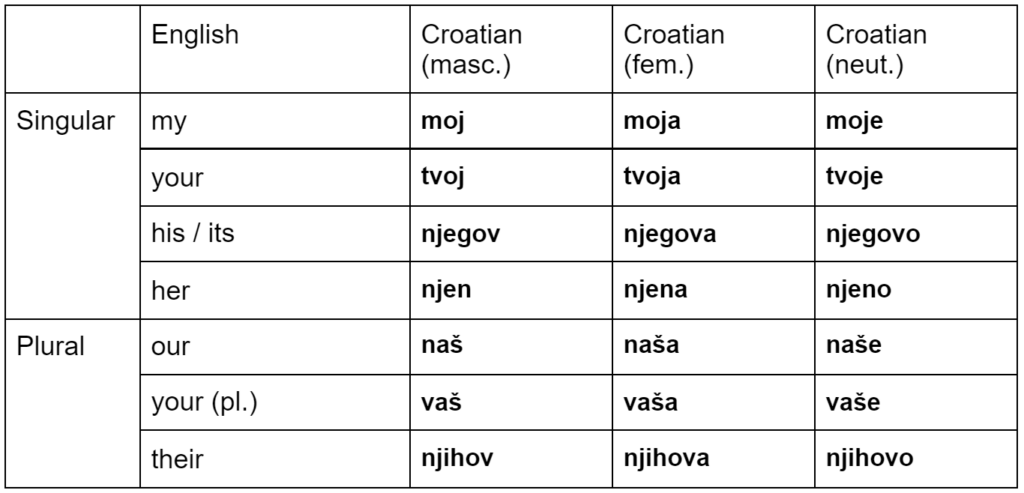
You’ll notice that some of these nouns have very similar forms, that’s why we’ll group them together and learn each group separately.
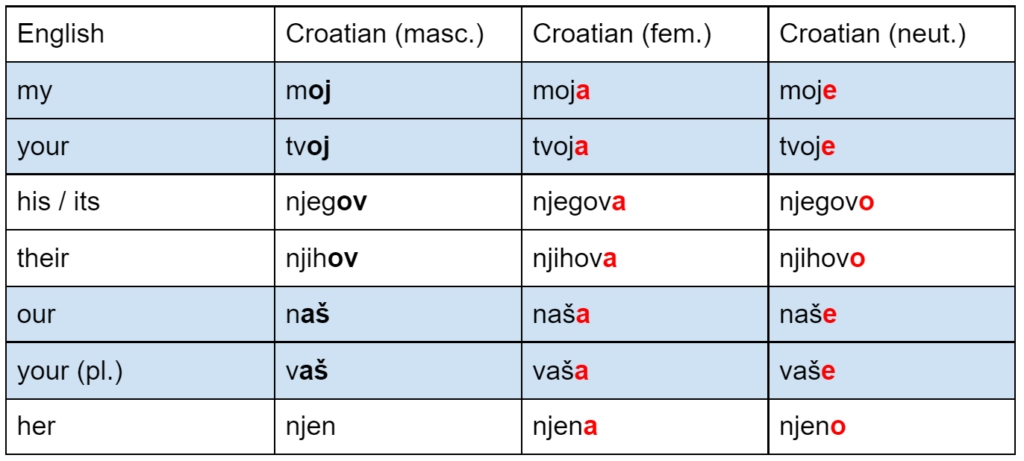
I have grouped similar pronouns together so it’s easier for you to memorize and learn them.
Let’s focus on the first group – my and yours.
The Possessive Pronouns moj (my) and tvoj (your)
Because possessive pronouns behave like adjectives, they need to match the noun with which they stand in the case, count, and gender.
This is the reason why there are actually three Nominative forms for each of the possessive pronouns.
It matters if you want to say that this is “my sister”, “my brother”, or “my village”, for instance, because these examples are all different in gender in Croatian.
If you know that the word “sister” is feminine grammatical gender, then This is my sister would sound like this:
Ovo je moja sestra.
[This – is – my(fem, N) – sister (fem. N)]
This is my sister.
The word for brother in Croatian is brat and this is a masculine noun. Therefore, the possessive pronoun also needs to be masculine:
Ovo je moj brat.
[This – is – my (masc., N) – brother (masc. N)]
This is my brother.
The word for a village in Croatian is neuter grammatical gender, and the Nominative form is selo.
Ovo je moje selo.
[This – is – my (neut., N) – village (neut. N)]
This is my village.
So, you’ve noticed that in each of these sentences there are three different forms for the word my, and these are:
my – moj (m.), moja (f.), moje (n.)
Remember that possessive pronouns act like adjectives so they have to match the noun in its grammatical gender, count, and case. So, moj will stand with masculine nouns, moja with feminine, and moje with neuter nouns.
If you’ve followed the above table closely, you noticed that another pronoun that has similar form to moj, moja, moje is the pronoun your – tvoj, tvoja, tvoje.
These two pronouns have the same endings for all the cases and so they are easily learned together.
Of course, not every noun and possessive pronoun will be in the Nominative case nor will it be singular. For this reason, it’s important for you to learn the cases and when each one of them is used.
In this article, I will shortly go through all the cases to show you each of the forms of the pronouns through different cases and when they are used. For more information about the different cases, please visit here.
Let’s check the form for the pronouns moj and tvoj through the different cases. A little disclaimer – these are just the basic forms. The more detailed forms will be explained later in this article.
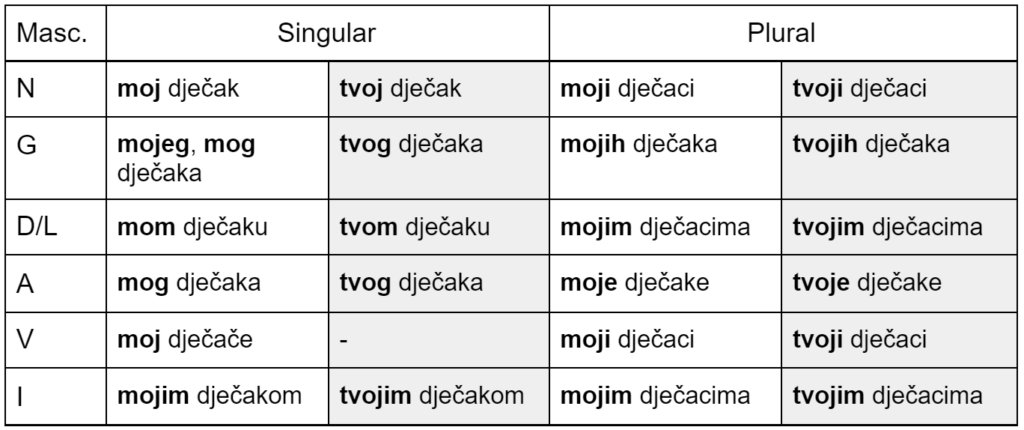
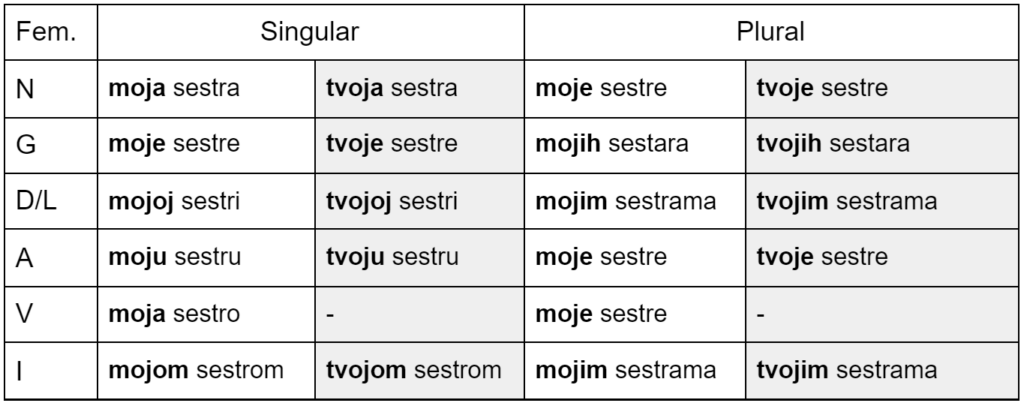
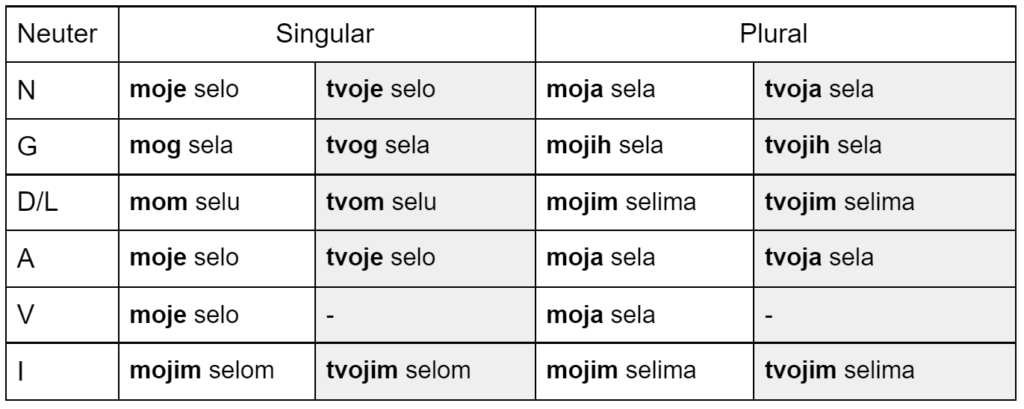
Notice that the masculine and neuter forms are very similar to each other, but be careful of some differences. Still, the similarity can help you memorize it easier. But, let’s dissect each group of nouns case by case.
The Nominative Case
The form for the nominative case for possessive pronouns are:

Words in the Nominative case are usually used as the subject or a part of the predicate.
Some examples where you would use the Nominative case are:
My sister is tall. – Moja sestra je visoka.
My brother is handsome. – Moj brat je zgodan.
My village is big. – Moje selo je veliko.
This is my sister. – Ovo je moja sestra.
This is my brother. Ovo je moj brat.
This is my village. – Ovo je moje selo.
The same form is used for the pronouns tvoj, tvoja, tvoje.
Your sister is tall. – Tvoja sestra je visoka.
Your brother is handsome. – Tvoj brat je zgodan.
Your village is big. – Tvoje selo je veliko.
This is your sister. – Ovo je tvoja sestra.
This is your brother. Ovo je tvoj brat.
This is your village. – Ovo je tvoje selo.
The Genitive Case
The form for the Genitive case of pronouns is a little more complex than the ones that were shown in the table above and they are:

Ok, first let’s see what’s up with these different forms for the masculine/neuter gender.
First of all, notice that the form for these two genders is the same in the Genitive case? This will make it easier to remember.
Second, the shorter forms (mog, tvog) are more common in everyday speech but you can use either one. The “a” in the brackets is added when you want to emphasize the pronoun.
Also, notice that the plural form doesn’t differentiate between genders. See, Croatian’s happy to be easy to learn in some instances!
So, when do you need to use the Genitive form? If you think of expressing the possession in English, you would use the genitive case. That is my sister’s book. “Sister’s” expresses the possession. The same would be done in Croatian.
In fact, the genitive case is the case of prepositions, partiality, and possession.
Visit here for more about the Genitive case.
To je knjiga moje sestre.
[That – is – book (N) – my sister (G, f, sing)]
That is my sister’s book.
Ovo je prijatelj mog brata.
[This – is – friend (N) – my brother (G, m, sing)]
This is my brother’s friend.
To je običaj mog sela.
[That – is – custom (N) – my village (G, n, sing)]
That is the custom of my village.
Normally, if you wouldn’t use the possessive pronoun, you would use a different word to express the possession (sister’s book would become a possessive adjective – sestrina knjiga; brother’s friend would become – bratov prijatelj, etc.).
But, because we are using the possessive pronoun, we need to use this word order, using the Genitive case.
The Genitive is also used with multiple prepositions:
Sjedim pored tvog prijatelja.
[I’m-sitting – beside – your friend (G, m, sing)]
I’m sitting beside your friend.
Ona živi blizu moje mame.
[She – lives – close – my mom (G, f, sing)]
She lives close to my mom.
Djeca trče oko tvog auta.
[Kids – they-run – around – your car (G, m, sing)]
The kids are running around your car.
Imam posao zbog tvog oca.
[I-have – job (A) – because of – your father (G, m, sing)]
I have a job because of your father.
Ići ću ja umjesto tvog brata.
[To-go – I-want – I (N) – instead – your brother (G, m, sing)]
I will go instead of your brother.
You can check out other prepositions used for the genitive here.
The Genitive is also used to express partiality. This is especially true when you look at your grocery list (a litter of milk – litra mlijeka, a kilo of meat – kilogram mesa, etc.) So, whenever you want to express partiality in that way, use the Genitive case.
Uzmi dio mog sendviča.
[Take – part (A) – my sandwich (G, m, sing)]
Take a part of my sandwich.
Posudit ću nekoliko tvojih olovaka.
[To-borrow – I-want – a few – your pencils (G, f, pl)]
I’ll borrow a few of your pencils.
The Dative/Locative Case
The Dative and Locative always have the same form so you can always learn them together.
The form of the possessive pronouns moj and tvoj for Dative and Locative is:

Again, you can certainly disregard the forms with the extra letter in the brackets. I’ve put this here for you to be aware that it’s out there and it exists, and you are welcome to use them when you want to emphasize the pronoun.
However, the basic forms mojem and mom (masculine and neuter), and tvojem, tvom are most common.
In fact, the easiest for you to learn is just mom and tvom because the other forms are less common.
Again, the plural form is the same for all three genders. How sweet, right?!
Now, when to use the Dative/Locative? For more detailed information, please refer to our video and article.
In general, remember the Dative/Locative case as the case for giving, transferring, or the case of the indirect object.
An indirect object is usually found in instances where someone is referring to someone or something else. For instance:
Želim ti poslati pismo.
[I-wish – you (D) – to-send – letter (A)]
I want to send you a letter.
As you can see in the previous sentence, the personal pronoun ti is the indirect object, while the word pismo is a direct object (that’s why it’s in the Accusative case, but more about that later).
So, whenever you think of giving something to someone, think Dative/Locative. Locals tell it apart by asking questions to whom, to what? This might be helpful for you in order to remember the indirect object.
Let’s look at some examples:
Želim poslati poruku tvom bratu.
[I-wish – to-send – message (A) – your brother (D, m, sing)]
I want to send your brother a message.
Dala sam loptu tvojoj sestri.
[She-gave – am – ball (A) – your sister (D, f, sing)]
I gave the ball to your sister.
Pričam priču tvom djetetu.
[I’m-telling – story (A) – your child (D, n, sing)]
I’m telling your child a story.
Želim se obratiti tvojim roditeljima.
[I-want – self – address – your parents (D, m, pl.)]
I want to address your parents.
Ona kupuje poklone tvom bratu i mojoj sestri.
[She – is-buying – presents (A, m, pl.) – your brother and my sister (D/L, m,f, sing.)]
She’s buying presents for your brother and my sister.
Dative is also used with some verbs and in some expressions:
- ići (to go) and other motion verbs
- smijati se (to laugh … at)
- diviti se (to admire)
- sličiti (to resemble)
- hvala + D (thank + D)
- zahvaljujući + D (thanks to + D)
Idem tvojoj sestri.
[I’m-going – your sister (D/L, f, sing)]
I’m going to your sister’s.
Smije se mojoj nesreći.
[Laughs – self – my bad luck (D/L, f, sing)]
He’s laughing at my bad luck.
Ona se divi mom radu.
[She – self – she-admires – my work (D/L, m, sing)]
She admires my work.
On sliči mom djetetu.
[He – resembles – my child (D/L, n, sing.)]
He resembles my child.
Uspjeli smo zahvaljujući tvojim idejama.
[We-made-it – are – thanking-to – your ideas (D/L, f, pl)]
We made it thanks to your ideas.
Moj vs. Svoj
This is a perfect place to explain the difference between moj and svoj.
Essentially, they mean the same thing and both can be translated as “one’s own”. Svoj is a reflexive possessive pronoun, and that means that it reflects back, or points back to the subject of the sentence.
Šaljem poruku svojoj sestri.
Šaljem poruku mojoj sestri.
[I’m-sending – message (A) – my sister (D)]
I’m sending a message to my sister.
Now, both of these sentences are correct, essentially. They mean the same thing. However, it is more correct to use the reflexive pronoun svojoj than the possessive pronoun mojoj because the indirect object reflects back to the subject.
The subject of the sentence is I. I am sending… a message to … my sister. The sister “belongs” to the subject, and so you need to use the reflexive pronoun “svoj” – one’s own.
The tricky part is that you can also send a message to your sister. Now this sentence will be like this:
Pošalji poruku svojoj sestri.
[Send – message (A, f, sing) – your sister (D, f, sing)]
Send a message to your sister.
Now the subject, the person doing the action, is you. You send… a message to … your own sister.
Now, the time when you have to use the possessive pronoun is when the pronoun doesn’t reflect back to the subject, like our previous example sentence:
Ona kupuje poklone tvom bratu i mojoj sestri.
[She – is-buying – presents (A, m, pl) – your brother and my sister (D/L, f, sing)]
She’s buying presents for your brother and my sister.
But, if she’s buying a present for her sister, then you need to use svoj again:
Ona kupuje poklon svojoj sestri.
[She – is-buying – present – her sister]
She is buying a present for her sister.
For more example sentences and explanations, watch the video:
The form for the pronoun svoj is as follows:
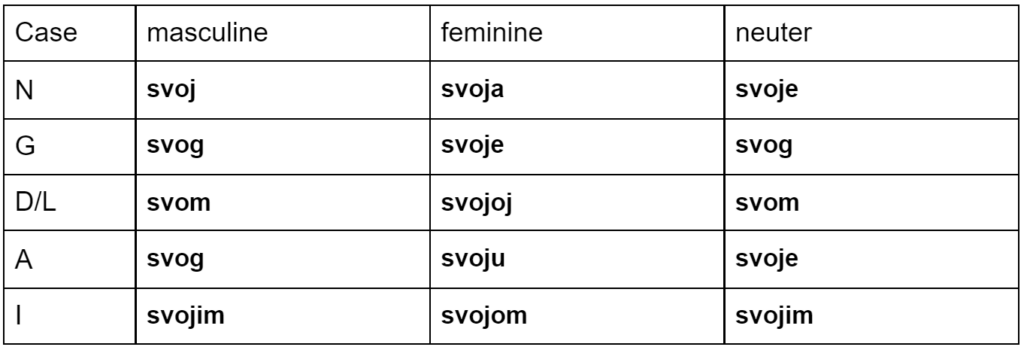
The Accusative Case
The form of the possessive pronouns moj and tvoj are:
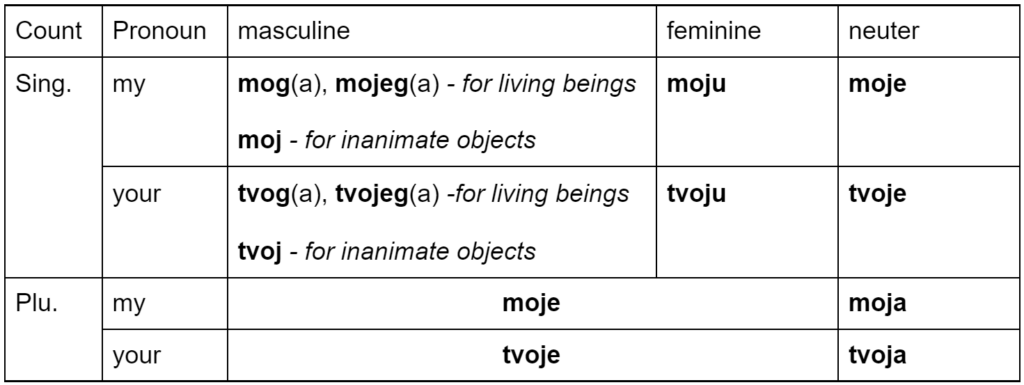
Now, let’s pay attention to a few things we’re encountering for the first time:
First, notice that there are two forms for the masculine. One form (a long and short one – feel free to go with the short one) is used when talking about a living being, and the other form, which is actually the same as the Nominative, is used when you’re talking about the inanimate things.
Second, the neuter form is the same as the Nominative form.
Third, the plural form for masculine and feminine is the same, and it looks the same as the singular neuter form, while the neuter plural form is the same as the feminine Nominative form!
As you can see, some of these pronouns will have the same form from one case to another, so pay attention to that when learning them. The best way to learn this and not get confused is if you learn it by phrases and not just as pronouns without an accompanying noun. So, I will include accompanying nouns at the end for all of these pronouns, to make your life easier.
Finally, when do you need to use the Accusative?
The Accusative case is the case for direct objects most of the time. It’s also used with some prepositions, which you can check out in this video or this article.
Now, let’s check out some examples. First I want to show you how you need to use the two different forms for the masculine pronoun:
Vidio sam tvog brata.
[He-saw – am – your brother (A, m, sing)]
I saw your brother.
Now, remember, we are using the Accusative because “your brother” is the direct object of the sentence.
Now, let’s see what happens when you’re referring to something inanimate.
Vidio sam tvoj automobil.
[He-saw – am – your car (A, m, sing)]
I saw your car.
The same sentence, different direct objects, different forms for the masculine…
Let’s continue with the examples:
Pozovi moju sestru!
[Invite – my sister (A, f, sing)]
Invite my sister.
Posjetit ćemo tvoje selo.
[To-visit – we-want – your village (A, n, sing)]
We’ll visit your village.
Volim tvoje prijatelje.
[I-love – your friends (A, m, pl)]
I love your friends.
Imamo pourku za tvoje sestre.
[We-have – message (A,f,sing) – for – your sisters (A, f, pl.)]
We have a message for your sisters.
Moramo pronaći tvoja stabla.
[We-have-to – to-find – your trees (A,n,pl)]
We have to find your trees.
Učinit ću sve za tvoje dijete.
[To-do – I-want – everything – for – your child (A, n, sing)]
I’ll do everything for your child.
The Instrumental Case
The form of the Instrumental case is:

Again, the form for the masculine and neuter is the same, as is the form for all three genders in the plural form.
Remember that the Instrumental case is the case of companionship or tools or means for doing something.
So, the rule of thumb is, whenever you have the word with or by, use the instrumental case. For more about the Instrumental case, please refer to our article.
Želim ići s tvojom prijateljicom.
[I-wish – to-go – with – your friend (I,f,sing)]
I want to go with your friend.
Ići ćemo mojim autom.
[To-go – we-want – my car (I,m,sing)]
We will take my car.
Razgovarala sam s tvojim prijateljima.
[She-spoke – am – with – your friends (I,m,pl)]
I spoke with your friends.
Piši mojom olovkom.
[Write – my pencil (I, f, sing)]
Write with my pencil.
Radujem se s tvojom majkom.
[I’m-rejoicing – myself – with – your mother (I,f, sing)]
I’m rejoicing with your mother.
The Vocative Case
The Vocative case is the case used when addressing someone or calling out to someone. For this reason, you can only use the Vocative case for the first person (my).
The Vocative form is actually the same as the Nominative form, it’s only used in different instances.

Moje drage sestre!
[My – dear – sisters (V, f, pl)]
My dear sisters!
Hej, moj prijatelju!
[Hey – my friend (V, m. sing.)]
Hey, my friend!
Draga moja djeco!
[Dear – my children (V, n, pl.)]
My dear children!
Ok, that’s all for the pronouns my and your. Keep practicing them with the corresponding noun that you know the best, and it will be easier to remember them!
Pronouns moj and tvoj through the cases
I’ll use the following nouns in sentences in order for you to remember the pronouns more easily.
The masculine noun automobil (car), the feminine noun djevojčica (girl) and a neuter noun računalo (computer).
The singular form of the noun moj
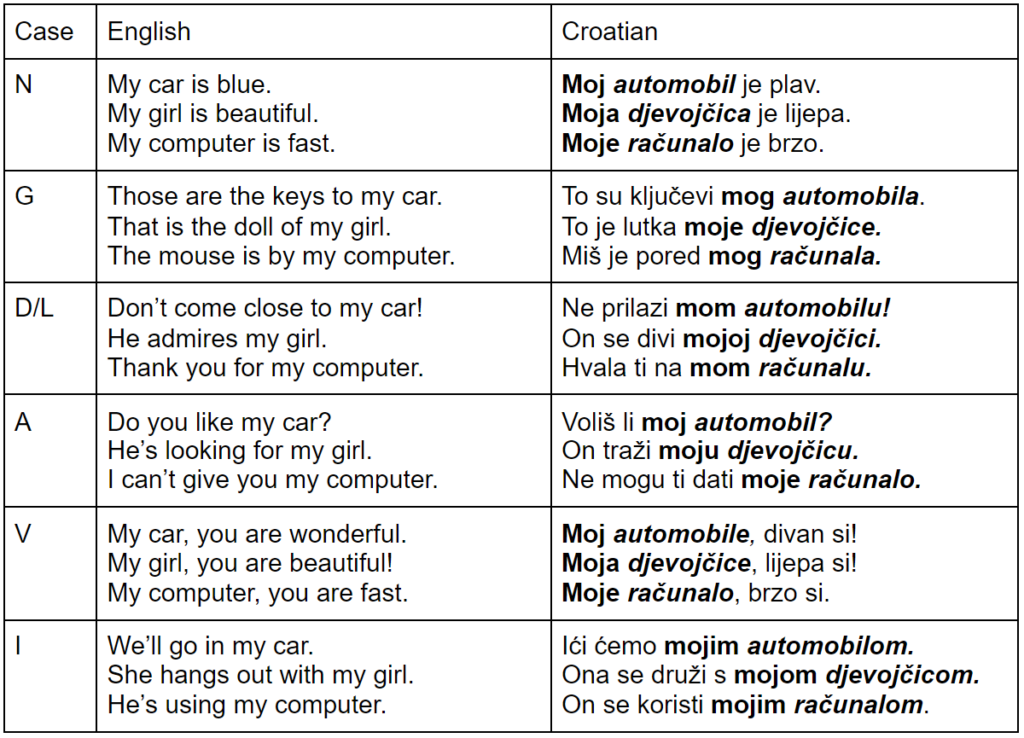
The plural form of the noun moj

The singular form of the noun tvoj
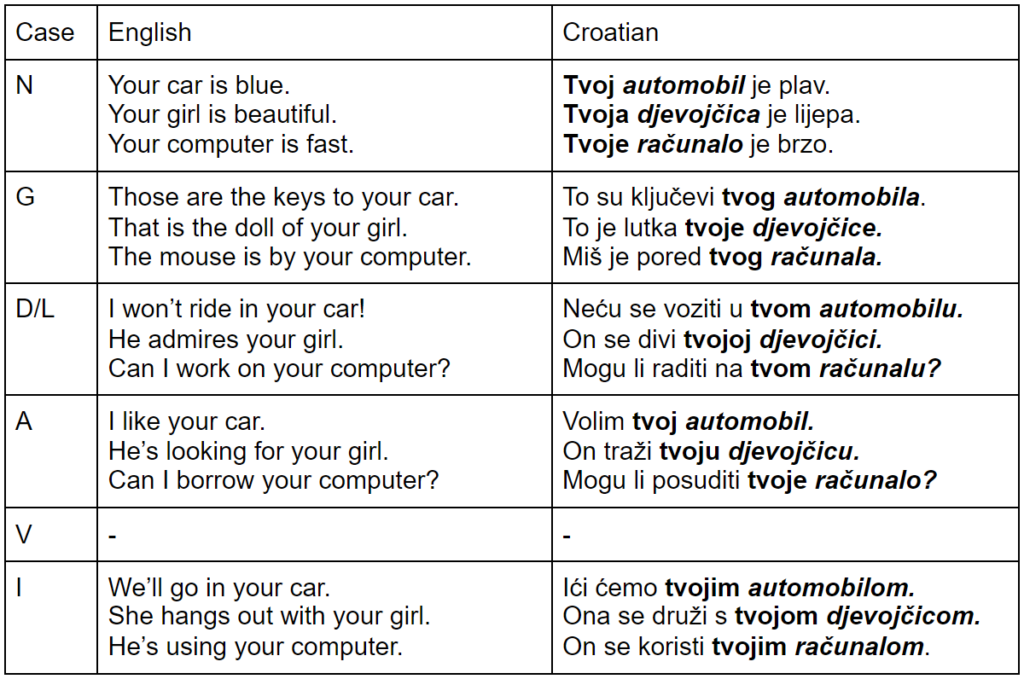
The plural form of the noun tvoj
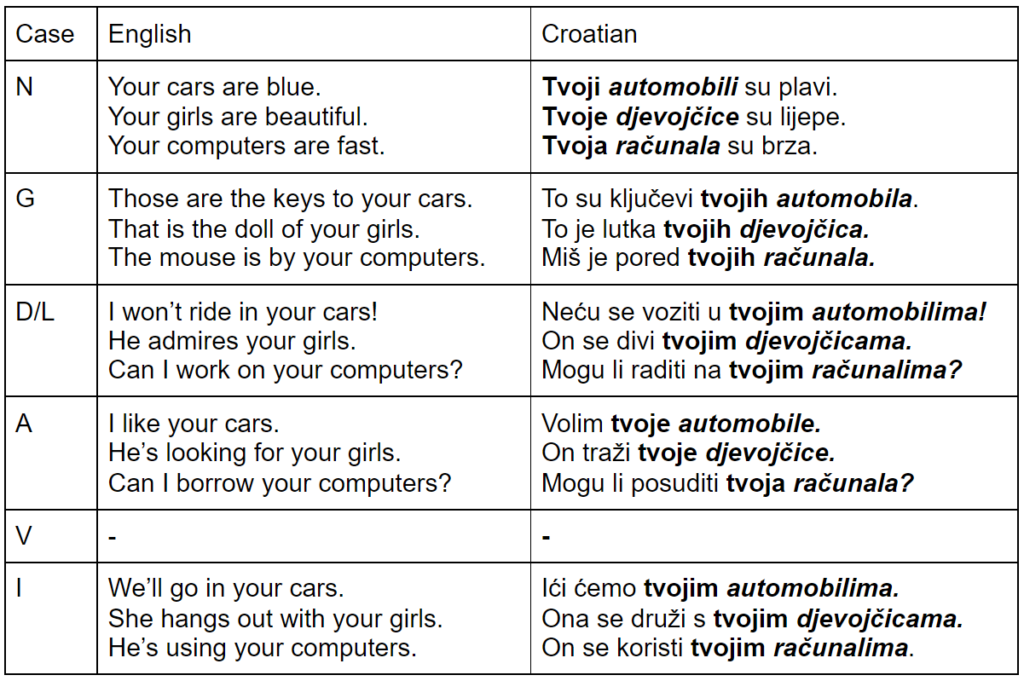
I hope this article has been helpful to either clear up some things or lead you into the introduction of the possessive pronouns in Croatian. Keep up the good work and keep studying!
Sretno!
